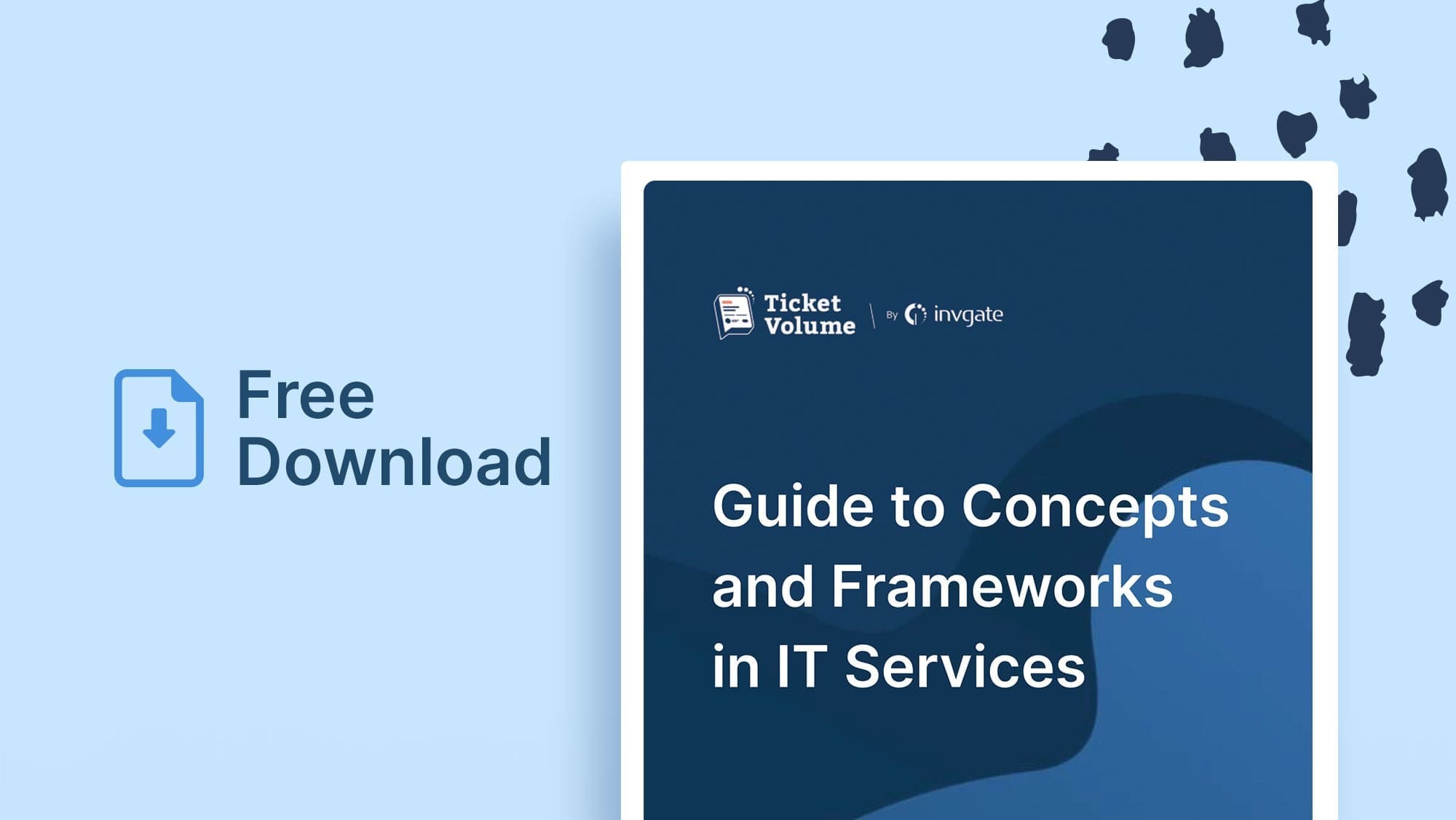When it comes to managing IT services and projects, two names often pop up: ITIL and Agile. These frameworks have made quite an impact in the IT world, each bringing its own approach to improving how we work.
As an IT professional, you've likely encountered one or both of these methodologies. But have you ever wondered how they fit together in the bigger picture of modern IT Management?
In this article, we'll referee the ITIL vs Agile match-up. We'll break down what they're all about, why they matter, and how they differ. But more than that, we'll explore how these two approaches can actually work together to make your IT operations more effective.

What is ITIL?
ITIL, or Information Technology Infrastructure Library, is a set of detailed practices for IT Service Management (ITSM). Developed in the 1980s by the UK government's Central Computer and Telecommunications Agency (CCTA), ITIL has become the most widely ITSM frameworks worldwide.
The ITIL framework consists of five core volumes:
ITIL focuses on aligning IT services with business and customer needs. It promotes a service lifecycle approach, emphasizing the importance of continuous improvement in service quality.
The key ITIL principles include:
- Focus on value
- Start where you are
- Progress iteratively with feedback
- Collaborate and promote visibility
- Think and work holistically
- Keep it simple and practical
- Optimize and automate
Benefits of ITIL
Organizations that implement ITIL often experience:
- Improved service delivery and quality
- Better alignment between IT services and business needs
- Increased efficiency in IT processes
- Enhanced customer satisfaction
- Reduced costs through optimized resource utilization

What is Agile?
Agile is an iterative approach to software development and Project Management that emphasizes flexibility, collaboration, and rapid delivery of working products.
It originated in 2001 when a group of software developers created the Agile Manifesto.
The Agile Manifesto outlines four core values:
- Individuals and interactions over processes and tools
- Working software over comprehensive documentation
- Customer collaboration over contract negotiation
- Responding to change over following a plan
Agile is a methodology that emphasizes flexibility, collaboration, and continuous improvement. It focuses on being adaptable to changes, working closely together as a team and with customers, and breaking work into small, manageable pieces completed in short cycles, known as iterations or sprints.
This approach creates frequent feedback loops, allowing for regular adjustments and improvements. Agile prioritizes customer needs and satisfaction and encourages a cultural shift to agile thinking, where teams embrace change, value open communication, and continually reflect on their processes to become more effective over time.
Other Agile principles include:
- Early and continuous delivery of valuable software
- Welcoming changing requirements
- Frequent delivery of working software
- Close, daily cooperation between business people and developers
- Building projects around motivated individuals
- Face-to-face conversation as the best form of communication
- Working software as the primary measure of progress
- Sustainable development pace
- Continuous attention to technical excellence and good design
- Simplicity
- Self-organizing teams
- Regular reflection and adaptation
Benefits of Agile
Organizations adopting Agile methodologies often report:
- Faster delivery of working products
- Increased flexibility and adaptability to changes
- Improved team collaboration and communication
- Higher customer satisfaction through frequent feedback
- Better quality products due to continuous testing and improvement

Comparing ITIL and Agile
While both ITIL and Agile aim to improve IT processes, they have different focuses:
- ITIL primarily addresses Service Management, while Agile focuses on project management and software development.
- ITIL provides a structured framework with defined processes, while Agile promotes flexibility and adaptability.
- ITIL emphasizes long-term planning and continuous improvement, whereas Agile focuses on short-term iterations and quick delivery.

Complementary aspects of ITIL and Agile
Despite their differences, ITIL and Agile can work together effectively. This combination, sometimes called "Agile Service Management," can significantly benefit organizations. Let's explore how these frameworks can complement each other in various aspects of IT Service Management:
- Incident Management: ITIL provides a structured approach to handling incidents, while Agile principles can enhance responsiveness. For example, an IT support team might use Agile techniques like daily stand-ups to quickly address and prioritize incoming incidents while still following ITIL's incident management process.
- Change Management: ITIL's Change Management or Enablement process ensures proper evaluation and approval of changes. Agile methods can be incorporated to speed up the process for low-risk changes. For instance, pre-approved changes for routine updates could be managed using Agile sprints, allowing for faster implementation while maintaining control.
- Service Design: ITIL's service design phase can benefit from Agile's iterative approach. Instead of designing a complete service upfront, teams can use Agile sprints to develop and test service components incrementally. This allows for faster delivery of core functionality and easier adaptation based on user feedback.
- Continual service improvement: Both ITIL and Agile emphasize continuous improvement. Organizations can use Agile retrospectives within ITIL's continual service improvement process to regularly identify and implement small, incremental service improvements.
- Project Management: While ITIL focuses on ongoing Service Management, it can be combined with Agile for project-based work. For example, a new service implementation could follow ITIL's overall service lifecycle, with the development phase managed using Agile methodologies like Scrum or Kanban.
- Knowledge Management: ITIL's Knowledge Management process can be enhanced with Agile principles. Teams can use wiki-style documentation and regular knowledge-sharing sessions to keep information up-to-date and accessible, aligning with both ITIL's focus on knowledge management and Agile's preference for working solutions over comprehensive documentation.
- Service Catalog Management: Agile techniques can be applied to ITIL's service catalog management. Teams can use iterative approaches to regularly update and refine the service catalog, ensuring it remains relevant and valuable to users.
- Customer Relationship Management: ITIL's customer-centric approach aligns well with Agile's focus on customer collaboration. Organizations can use Agile techniques like user stories and regular customer feedback sessions to inform and improve ITIL's customer relationship management processes.

Implementing ITIL and Agile in Your Organization
To effectively implement ITIL (Information Technology Infrastructure Library) and Agile methodologies in your organization, it's crucial to understand where each approach fits best. Consider the following factors to guide your decision-making process:
- The nature of your projects and services: Evaluate the types of projects and services your organization handles. ITIL is often more suitable for managing ongoing services and operational processes, while Agile is ideal for projects that require flexibility and rapid iteration.
- Your organizational culture and structure: Assess your organization's culture and structure. ITIL may fit well in environments that value structured processes and standardization, whereas Agile thrives in cultures that embrace adaptability and continuous improvement.
- Customer requirements and expectations: Understand your customers' needs and expectations. ITIL can help ensure consistent service delivery, while Agile can respond quickly to changing customer requirements.
- Current pain points in your IT processes: Identify the specific challenges and inefficiencies in your current IT processes. This will help you determine which approach, or combination of approaches, can best address these issues.

Choosing the right approach
When deciding between ITIL vs Agile, or a combination of both, consider the following factors:
- Project size and complexity: Large, complex projects may benefit from the structured approach of ITIL, while smaller, more dynamic projects can thrive with Agile's flexibility.
- Team size and distribution: The size and distribution of your team can influence your choice. Agile works well with small, co-located teams, while ITIL can be more effective for larger, distributed teams.
- Regulatory requirements: Consider any regulatory or compliance requirements that may necessitate the structured processes of ITIL.
- Customer involvement: Assess the level of customer involvement in your projects. Agile emphasizes close collaboration with customers, while ITIL focuses on standardized service delivery.
- Speed of delivery requirements: Evaluate the need for rapid delivery. Agile is designed for quick iterations and frequent releases, while ITIL ensures consistent and reliable service delivery.
Practical tips for integrating ITIL and Agile
Overall, we think integrating Agile practices into ITIL environments can enhance the flexibility and responsiveness of your team while maintaining the benefits of structured processes. Here are some practical steps to achieve this integration:
- Start small: Begin with a pilot project or team
- Provide training: Ensure staff understand both ITIL and Agile principles
- Adapt processes: Modify ITIL processes to incorporate Agile elements where appropriate
- Foster communication: Encourage collaboration between ITIL and Agile teams
- Measure and adjust: Regularly assess the effectiveness of the integration and make necessary changes
Conclusion
The world of IT management is constantly evolving, and so should our approaches to it.
As we close, it's clear that the debate of ITIL vs. Agile is not as relevant as all the ways to blend these approaches and skillfully combine their strengths. By doing so, IT teams can better meet the ever-changing needs of their businesses and customers, ensuring they stay ahead in the fast-paced world of technology.
The combination of ITIL's structured approach to Service Management and Agile's flexibility in project execution can lead to more responsive, efficient, and customer-focused IT services.
Remember, the goal is to improve service delivery and meet customer needs – use these frameworks as tools to achieve that objective, rather than viewing them as rigid rules.














.jpg?upsize=true&upscale=true&width=780&height=205&name=ITIL%20Foundation%20Exam%20(2).jpg)
